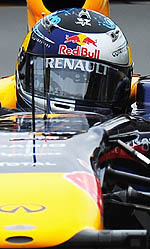


06/04/2011
NEWS STORY
 Renault Sport - the engine-builder, not the F1 team - supplied fans and media alike with an interesting tidbit of information in their Malaysian Grand Prix preview. Towards the end of the press release, under the casual header "Did you know..." Renault Sport reveals the effect of 2011's blown floors on overall fuel consumption.
Renault Sport - the engine-builder, not the F1 team - supplied fans and media alike with an interesting tidbit of information in their Malaysian Grand Prix preview. Towards the end of the press release, under the casual header "Did you know..." Renault Sport reveals the effect of 2011's blown floors on overall fuel consumption.
"The blown floors prevalent in the field this year mean that engine and exhaust management is even more crucial than in previous seasons," the release says. "To power a blown floor effectively and generate additional downforce, an engine must produce significant amounts of exhaust gas.
"Simply put, the more fuel burned, the more exhaust is produced and potentially more downforce. Since the RS27's fuel consumption rate is extremely good, the Renault-equipped teams were able to burn 10 percent more fuel than normal during the Australian Grand Prix without running out of fuel, therefore giving more exhaust flow to its partners using the blown diffuser."
While not every car on the grid is making use of the blown floor - yet - it is interesting to have confirmation of the extra fuel needed to capitalise on the added downforce available.
Renault Sport has been open about the extra fuel used because they are proud of their engines' fuel efficiency. While their customers will be joining the other blown floor teams in using more fuel than was typical in 2010, the feeling at Viry-Châtillon is that those teams powered by the RS27 will be able to carry lower fuel weights off the start without compromising the advantages offered by the blown floor.
The Australian Grand Prix has one of the highest fuel consumption rates on the calendar irrespective of the make of engine used. In contrast, the Sepang International Circuit sees only medium fuel consumption. But the Malaysian Grand Prix presents its own challenges to engines.
Engine cooling and management will be vital in this weekend's grand prix. Average air temperatures in Malaysia in April hover around 30°C, while track temperatures of 43°C are not uncommon. Humidity is another contributing factor, and levels often reach 100 percent.
According to Renault Sport, "maintaining fuel temperature without compromising on performance is also vital in Sepang. The high ambient temperatures can cause fuel to run over the recommended temperatures, meaning a lower grade fuel must be used by engine suppliers. Renault's fuel partner, Total, produces two types of fuel for use with the RS27 and despite the high Malaysian ambient heat, Renault's partners are still able to use the most high-spec of fuel since both Total and its customers have made progress in the chemical characteristics and insulation."
Renault Sport has three customers on the 2011 grid: Renault, Lotus, and current world champions Red Bull. The 2011 season marks the first time since the mid-1980s that Viry-Châtillon has supplied more than two teams - in 1985 and 1986, Renault, Lotus, Ligier, and Tyrrell all used Renault's V6 turbo EF15 engines. At the end of 2010, Lotus moved from Cosworth power and joined Red Bull and Renault as customers of Renault Sport.
All four of Formula 1's current engine suppliers provide their engines to three teams. Cosworth's CA2011 powers Williams, Virgin, and HRT; the Ferrari 056 is used by Ferrari, Sauber, and Toro Rosso; while the Mercedes FO 108Y can be found under the hoods at Mercedes, McLaren, and Force India.
Of the four engine makes on the 2011 grid, the Ferrari 056 is widely held to be the thirstiest.